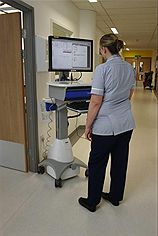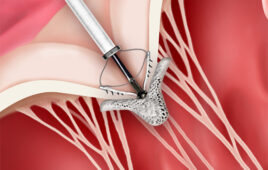-
£1.4 million per annum saved ongoing as the Trust aims
to close its records library by 2014 -
Trust planning to become ‘paper free’ not just
‘paper light’
November 12, 2010 – C Cube Solutions announces that
Merseyside-based St Helens & Knowsley Teaching Hospitals NHS
Trust has completed a pioneering project to deliver health records
electronically using its C Cube electronic document management
software (EDMS), integrating with Kodak document scanners.
The Trust has migrated away from a labour intensive and
unsustainable paper process and is the first Trust in the UK
– as far as is known – to stop using paper records in
operational practice.

Nurse using new electronic patients record system
This landmark initiative provides instant access to health
records, enhances patient safety through 100% records availability,
improves clinical effectiveness and saves money. Secure and
simple to use, the system has the full support of users, is built
on standards-based not propriety technology, and provides future
expandability.
All 27 hospital departments have now gone ‘live’
– following a 22 month roll out – with over 500 clinicians
and 130 medical secretaries now trained to use it.
The Trust can now guarantee that the correct patient file is
available when needed, irrespective of location, which could not be
achieved with the old paper process given the logistics involved in
moving 7,000 records every week for 349,285 outpatients visits
annually. With 90,000 new patients registered every year this
quantity was expanding exponentially.
The Trust has invested £338 million to rebuild its two
hospital sites. St Helens Hospital opened to patients in
October 2008, and the new Whiston Hospital in April 2010.
Electronic records are integral to delivering excellent patient
care in world-class facilities.
While this project is primarily about improving patient safety
and care, £1.4 million per annum will be saved
ongoing as the Trust aims to close its records
library in 4 years (2014). All paper files will be dispensed with
and storage facility will not be required. The cost savings
are greater than first imagined. In the original business case, the
Trust expected to save over £3.2 million over a 5 year period
from an investment of £1.2million.
This is because not as many records as first thought will need
to be scanned. When the project started, it was expected that
671,800 records would be scanned over 5 years. To date, 134,389
complete records have been digitised equating to over 41.3 million
pages.
The Trust has to keep standard records for an eight year period
– the mean age of each is four years – after which files can
be destroyed. The Trust is therefore scanning records required,
destroying those which are not, with the library therefore
shrinking faster than was originally envisaged as new files are not
being added.
The C Cube Solutions EDMS installation is unique in the NHS for
two reasons:
First, scan-on-demand has been adopted where medical records for
patients coming into the hospital are scanned, with the EDMS used
to deliver them. The Trust is digitising live files only. It
rejected scanning the whole library of 700k files each containing
on average 350 pages. A study estimated it would take 10 full
time staff 30 years to do it – too time consuming with no patient
value added.
All staff involved in paper records have been moved from the
library to its scan-on-demand department to form a team of 52
people.
Kodak i660 and i780 high performance production scanners
digitise the paper files and cope with vast daily scanning volumes.
Bar coding is used to indicate that a new patient file is being
scanned and/or to scan into different chapters.
Second, a bespoke portal for the system was created by C Cube
Solutions to make the project clinically viable. This is the first
time this has been done in the NHS. It offers a single, simple and
safe point of access to view and access records so that the
treating clinician can see the patient’s medical
history.
The screen displays information for instance patient name,
appointment time, last doctor’s letter, and has a range of
links (virtual chapters) into the EDMS so that a clinician can
easily delve into the patients’ medical history.
Duplicated information and department-based repositories have
been removed, with the system integrating with other IT solutions
like the Patient Administration System which has minimised
unnecessary development work or duplication of
technology.
The EDMS runs on four clustered HP servers with all patient data
(over 14TB) stored on two HP SANS, backed up to tape and optical
disc to ensure robust disaster recovery.
At the beginning of the project, the Trust started with health
records for outpatient clinics only, but over the past year, has
extended it to ward admissions and use in-theatre. This means that
every patient coming into hospital is now seen using the system and
paper records are not delivered anymore.
In terms of rollout, new departments could only be bought online
step-by-step. On average, patients revisit outpatient clinics three
times per condition. While it takes time and resources to scan a
patient’s file for the first visit, for the second and third
visits there is no staff overhead to prepare files as they are
already available electronically. Over time, the paper-based
library is therefore reduced, with staff then free to scan other
departments’ records.
While other health providers have failed to implement EDMS
solutions successfully, the Trust has ensured that this massive
business change programme has worked. This has been achieved
through: executive and board level sponsorship; proper financial
resourcing; careful system design; and thorough engagement and
consultation with all stakeholders. This meant that the
implementation was not done “to” them
but “with” them.
In addition, highly capable project managers have made extensive
effort with communication, engagement and support to avoid staff
becoming disenfranchised, disconnected and refusing to accept
change.
Neil Darvil, the Trust’s director of informatics, says,
“This is a significant campaign and a long journey where you
need the whole organisation from records staff to executives, the
Trust board and clinicians all lined up, signed up to agreed common
objectives, with proper communication to achieve success.
It’s not a quick fix solution where you can just implement
new IT, sit back and expect acceptance. It’s tough to
do.”
In addition to the financial ROI, the impact of the new system
has been significant as follows:
-
Patient risk is greatly reduced because all medical history is
available at the point of care – guaranteed. -
Admissions from the A&E department have reduced as
clinicians now have instant access to scanned notes thus avoiding
admitting people unnecessarily. -
Appointments can be made at short notice and patients can see
several specialists per visit because case files are
accessible. -
Multidisciplinary teams meetings are easier and can be done over
the phone or via a PC rather than everyone having to physically
meet to share one file. -
Less complaints are made. Historically, 40 per annum were
received specifically around records from individuals sent home
because doctors had not received files on time. -
The portal has been systematically developed to make navigation
quicker based on clinical feedback. This has included: two
page views, bookmarking, thumbnails, clinic and ward views and
hiding blank pages. -
The system has been enhanced so that all patient correspondence
is now produced in C Cube including ad hoc letters whereas
previously it was only correspondence related to clinic visits. The
Trust has avoided buying and integrating other software to do
this. -
Moving forward the Trust is planning to develop the EDMS system
by adding direct data entry capabilities to turn it into a
fully-fledged Electronic Patients Records system. Today the Trust
is “paper light”, moving forward, it will be
“paper free.” The first pilot will start before
Christmas 2010. -
Access to the system will be extended to GPs and other primary
care professionals via a voice and data network which interconnects
340 sites in Merseyside. A consultation process is underway with
the project team anticipating making this available in
2011.
Vijay Magon, C Cube Solutions’ managing director, says,
“This project is an impressive advert for the NHS and
actually what can be achieved when IT truly delivers and is aligned
with organisational goals. The Trust has invested in brand
new multi million pound facilities, with e-health records playing a
key part in delivering world-class patient care. Real-time access
to information using a scan-on-demand approach has ensured a better
clinical experience through 100% case notes
availability.”
David Whitton, Kodak’s EMEA sales manager, northern
cluster, says, “Much has been reported in the press
about the Government wishing to make patient medical histories
available online. The Trust can deliver this today without doing
anything significantly extra – the hard part of getting all
data on patients in an electronic format has been done and is
available now.”
– ENDS –
About C Cube Solutions
C Cube Solutions, formerly trading as OITUK, is a specialist
provider of electronic document management & workflow solutions
that encompass imaging, electronic document and records management,
workflow, electronic forms, portal-based business applications and
collaboration facilities.
C Cube Solutions has an extensive track record working with
organisations in local government, health, financial services and
commerce. Visit www.oituk.com for further
information.
About Kodak
As the world’s foremost imaging innovator, Kodak helps
consumers, businesses, and creative professionals unleash the power
of pictures and printing to enrich their lives.
To learn more, visit www.kodak.com and follow our blogs
and more at www.kodak.com/go/followus.
More than 75 million people worldwide manage, share and create
photo gifts online at KODAK Gallery–join today at www.kodakgallery.com.
Choose from the widest selection of Kodak digital cameras,
all-in-one inkjet printers, pocket video cameras and more at http://store.kodak.com.
For further information, please contact
Tom Herbst
Tom Herbst PR
T:07768 145571
Email: tom@tomherbstpr.co.uk




